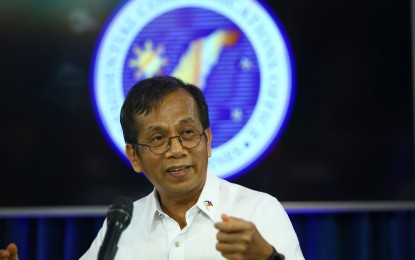
POVERTY REDUCTION. National Economic and Development Authority Secretary Arsenio Balisacan on Monday (July 22,2024) said the government's goal to reduce poverty to a single-digit level by 2028 is attainable. Data from the Philippine Statistics Authority showed that the poverty rate fell to 15.5 percent as of end-2023 from 18.1 percent in 2021. (PNA file photo)
MANILA – The country's poverty rate fell to 15.5 percent in 2023 from 18.1 percent in 2021, the Philippine Statistics Authority (PSA) said on Monday.
The poverty incidence during the period surpassed the government's 16 percent to 16.4 percent target in the Philippine Development Plan 2023-2028.
Preliminary results of the Family Income and Expenditure Survey (FIES) released by the PSA showed that this was equivalent to 17.54 million Filipinos whose income is not sufficient to meet their basic food and non-food needs.
This is down from the 19.99 million poor Filipinos recorded in 2021.
Poverty incidence among families also fell to 10.9 percent or equivalent to 3 million poor families from 3.5 million families as of end of 2021.
In a separate statement, the National Economic and Development Authority (NEDA) said the decline in poverty incidence last year marked significant progress toward the government's goal of reducing poverty to a single-digit level by 2028.
“These encouraging figures underscore our unwavering commitment to implement effective policies and initiatives that uplift the lives of our countrymen. As we welcome news of our progress, we remain steadfast in our efforts to ensure that our economic gains are truly felt by all Filipinos, rich and poor alike,” NEDA Secretary Arsenio Balisacan said in a statement.
The number of food-poor families decreased to 740,000 in 2023 from 1.04 million families in 2021.
In terms of population, the number of food-poor Filipinos also saw a significant decline, dropping from 6.55 million in 2021 to 4.84 million in 2023.
The country’s average per capita income increased by 17.9 percent between 2021 and 2023, outpacing the 15.3 percent rise in the annual per capita poverty threshold during the same period.
“High inflation during the first half of 2023 likely partially offset the positive effects of income growth on poverty reduction. The decline in poverty could have been sharper had inflation been more moderate," Balisacan said.
"But what is perhaps most encouraging to see is that mean per capita incomes for the poorest Filipinos —those belonging to the bottom deciles— grew quite fast, faster than those in the top decile classes and faster than the rate at which the poverty threshold grew. In other words, economic growth was progressive,” he added.
Balisacan assured that food security would continue to be the government's top priority.
"We know what we have to do to ensure that food is available, accessible, affordable, and nutritious. We must boost agricultural productivity; invest massively to improve our infrastructure and markets; effectively manage food prices through supply- and demand-side interventions; and strengthen targeted interventions to enhance health outcomes,” Balisacan said.
“At the same time, we continue to work on the creation of more and higher-quality jobs and human capital development to enhance Filipinos’ income-earning abilities. We must also strengthen our social safety nets by harnessing digital technologies so that the poor and vulnerable are partially shielded from economic shocks,” he added.
Balisacan said that with the right policies in place and the further acceleration of government programs, a single-digit poverty rate by 2028 is achievable.
"The government is resolute in its commitment to ensuring rapid, sustained, and inclusive economic growth. Despite the challenges, we will stay the course: together, we will ensure that no Filipino is left behind as we build a nation where prosperity is shared by all,” he said.
Sought for comment, Rizal Commercial Banking Corporation chief economist Michael Ricafort said the further reopening of the Philippine economy supported improvements in economic and business conditions that generated more jobs, livelihood, and other opportunities, thereby lifting more people out of poverty.
Ricafort said the government could achieve its 2028 poverty rate target "if more people are lifted from poverty in the agricultural sector, which employs more than 20% of all workers in the country."
This could be achieved by further boosting productivity and reducing costs with the increased use of the best global technology, he said.
"These interventions would help boost incomes of farmers and lift more people from poverty especially in the rural areas, leading to more inclusive economic growth and development that fundamentally reduce further the overall poverty rate," he added. (PNA)
